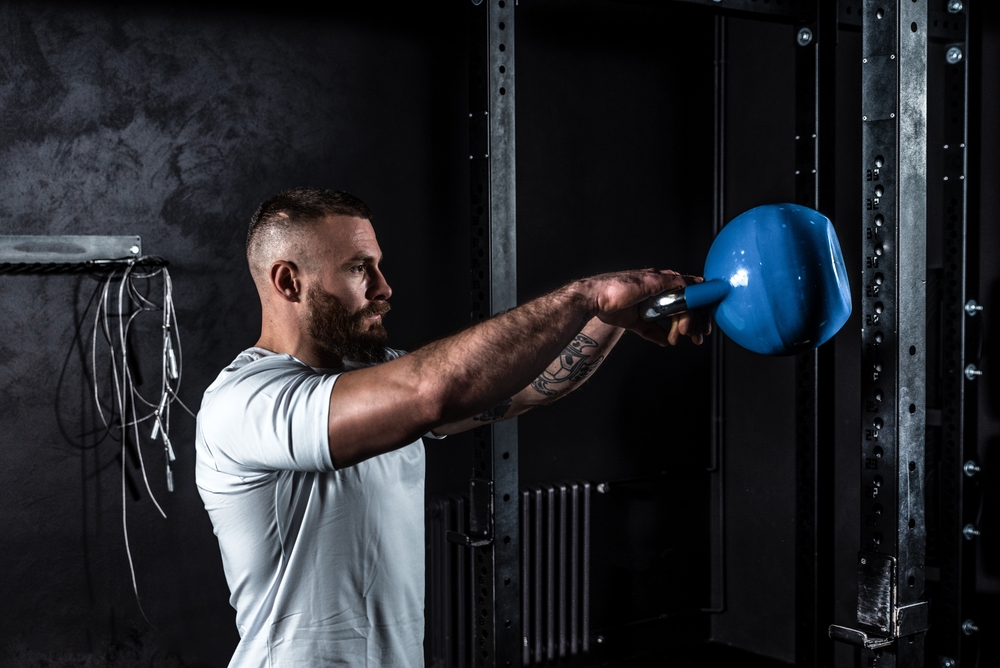A proper kettlebell swing is a hip hinge movement where you explosively snap your hips forward to drive the kettlebell upward—not a squat, and definitely not an arm exercise.
The power comes from your glutes and hamstrings, while your arms simply connect you to the bell as it floats to chest height.
Keep reading for the complete breakdown of setup, execution, breathing technique, and the most common mistakes that could be holding you back.
Understanding What Makes a Kettlebell Swing Work
Before you even touch a kettlebell, you need to understand what's actually happening during a swing.
This isn't a squat variation where you sit down and stand up. It's a hip hinge—a completely different movement pattern where your hips shoot backward while your torso tips forward, creating a powerful loading position.
The magic happens in your posterior chain.
Your glutes, hamstrings, and lower back generate all the force needed to send that kettlebell flying upward.
If you're feeling this exercise primarily in your shoulders or arms, you're doing it wrong.
Those muscles play almost no role in a proper swing.
Here's a useful way to think about it: imagine a deadlift performed at high speed with momentum carrying the weight upward.
That explosive hip extension—the moment when you snap your hips forward and squeeze your glutes hard—is what launches the kettlebell.
Your hip snap drives the bell forward horizontally first, and that momentum carries it up.
Your arms? They're just ropes. Seriously. They connect you to the kettlebell but don't actively lift it.
The moment you start pulling with your arms or raising your shoulders, you've shifted away from the intended mechanics.
Let your hips do the work while your arms stay relatively passive, simply guiding the bell through its arc.
This distinction matters because using the wrong muscles not only makes the exercise less effective but also increases your injury risk.
When your hips generate the power, your spine stays protected and your core stays engaged.
When your arms take over, your lower back compensates, and that's when problems start.
Setting Up Your Starting Position Correctly
Setup determines everything that follows.
Get this wrong and you'll struggle through every rep, compensating with the wrong muscles and wondering why swings feel awkward.
Start by standing about one foot behind the kettlebell.
This distance matters—too close and you'll crowd the bell during the backswing, too far and you'll have to reach excessively.
Place your feet slightly wider than hip-width apart.
You need enough space for the bell to pass cleanly between your legs without clipping your knees or thighs.
Here's the sequence most people get backward: find your hip hinge position first, then reach for the bell.
Don't bend down and grab it, then try to arrange your body around it.
Push your hips back, let your torso tip forward naturally, and only then extend your arms to grip the handle.
This ensures you're starting from a strong, loaded position rather than a compromised one.
Before your hands touch that handle, squeeze your shoulder blades together and rotate your arms so the pits of your elbows face outward.
This external rotation activates your lats, creating a stable shelf of muscle that protects your spine throughout the movement.
Skip this step and your shoulders will drift forward, pulling your entire upper body out of alignment.
Your neck position deserves attention too. Keep your eyes on the floor roughly six feet in front of you.
This maintains a neutral cervical spine aligned with the rest of your back.
Looking up hyperextends your neck, looking down rounds your upper back—neither helps you.
Weight Selection Guidelines
Men should start with 16kg (35 pounds), women with 8-12kg (18-26 pounds).
These aren't arbitrary numbers.
Going too light creates a different problem than you'd expect—without enough load, you can't properly engage your hips.
You'll end up muscling the bell around with your upper body simply because there's not enough resistance to require hip power.
Too heavy and you'll overcompensate with your arms and lower back, which defeats the entire purpose.
Footwear Matters
Train in flat-soled shoes or barefoot.
Soft, cushiony running shoes compress under load, creating an unstable base that disrupts your entire kinetic chain.
You need a firm connection to the ground to generate and transfer power efficiently.
The Five-Phase Swing Execution
The swing isn't one continuous motion—it's a sequence of distinct phases that flow together.
Understanding each phase separately helps you identify where your technique breaks down.
1. The Hike
Grip the bell tightly and hike it back between your legs like you're snapping a football.
Your arms stay straight, your knees bend slightly, and your wrists should make contact right at the bottom of your zipper line during this backswing.
Feel that stretch building in your hamstrings.
That tension loading up in the back of your legs tells you you're in the right position and ready to explode forward.
2. The Hip Drive
When your hamstrings hit maximum tension, that's your trigger.
Explosively drive your hips forward, squeeze your glutes as hard as you can, and lock out your knees.
This hip snap generates all the power—your shoulders contribute nothing here.
Most people underestimate how aggressive this movement needs to be.
It's not a gentle push; it's a violent forward thrust of your hips.
3. The Float
Here's where you do nothing.
The momentum from your hip drive propels the bell upward while you simply hold on.
Your elbows stay softly bent, never rigid, and your arms remain passive.
For the Russian-style swing (which you should master before attempting American overhead swings), the bell rises to roughly chest or shoulder height.
If you're pulling with your arms to get it there, you've missed the point entirely.
4. The Lockout Position
At the top, you're standing bolt upright. Your core is locked tight, glutes still squeezed, knees still locked.
Imagine your upper body is in a plank position, but instead of being horizontal on the ground, you're vertical with your torso hinged on your hips.
Here's what you're not doing: leaning backward or hyperextending your spine.
Stand tall and vertical—that's it.
5. The Descent
Gravity pulls the bell back down, and timing this phase separates good swings from poor ones.
Wait until the bell is falling toward your thighs before you hinge at your hips again.
Don't squat down early trying to catch it. Let it drop, then hinge back to absorb the weight and load up for the next rep.
This patience in the descent keeps the rhythm smooth and prevents the jerky, disconnected swings you see in most gyms.
Breathing Technique for Power and Stability

Most people ignore breathing until they're gasping between sets, but your breath pattern directly affects how much weight you can move and how safe your spine stays under load.
Here's the rhythm: during the downward phase while you're standing upright, inhale deeply through your nose.
Fill your stomach with air—not your chest.
Push your navel forward and slightly down as you breathe in.
This creates what's called intra-abdominal pressure, turning your core into a rigid cylinder that supports your spine from the inside.
As you explosively thrust your hips forward and drive the bell upward, exhale forcefully through your mouth.
This exhalation should be short, sharp, and timed exactly for the moment when your hips lock out at the top of the swing.
Some people make an audible “tss” or “huh” sound—that's fine.
What matters is that forceful expulsion of air coordinated with peak force production.
This isn't arbitrary.
The breathing pattern serves two purposes.
First, it maximizes core stability during the most vulnerable moment of the lift when forces on your spine peak.
Second, it establishes a rhythm that keeps your movement smooth and coordinated.
When your breathing falls out of sync with the swing, your entire technique deteriorates.
You'll notice yourself holding your breath, rushing reps, or losing that crisp snap at the top.
Get this dialed in early.
Practice the breathing pattern with light swings until it becomes automatic, because once you're working with heavier bells and higher rep counts, you won't have mental bandwidth to think about when to inhale and exhale.
Seven Critical Mistakes That Ruin Your Swing
Watch people swing kettlebells in any gym and you'll spot these errors within seconds.
Each one either reduces the exercise's effectiveness or sets you up for injury.
Squatting Instead of Hinging
This is the most common mistake and the hardest to fix because it feels more natural to squat.
When you squat, your knees travel forward and your torso stays relatively vertical.
You're loading your quads instead of your posterior chain, which eliminates the explosive hip power that makes the swing work.
The movement should feel like you're pushing your hips back to touch a wall behind you, not sitting down into a chair.
Leaning Back at the Top
Some people finish each rep by arching their back and leaning backward, thinking this adds power or range of motion.
It doesn't.
It just compresses your lumbar spine unnecessarily.
The top position should be perfectly vertical—standing tall with glutes squeezed and core tight, but not hyperextended.
Using Arms to Lift
If your shoulders are burning after a set of swings, you're lifting with your arms instead of driving with your hips.
Your arms and shoulders should feel almost uninvolved, like they're just hanging on while your hips do all the work.
Power must come from the hip snap, not from pulling the bell upward with your upper body.
Rounding the Back
Losing your neutral spine position—letting your back round forward—prevents your core from engaging properly and dramatically increases injury risk.
Your spine should maintain the same neutral curve from setup through the entire movement.
If you can't keep a flat back, the weight is too heavy or you haven't mastered the hip hinge pattern yet.
Shallow Hinge
Without enough depth in your backswing, you can't generate meaningful power.
The bell should travel back far enough that you feel a strong stretch in your hamstrings.
A good cue: imagine trying to touch the kettlebell to a wall directly behind you during the backswing.
That depth loads the posterior chain properly for an explosive forward drive.
Poor Foot Position
Unstable footing disrupts your entire kinetic chain.
If you're training in soft, cushiony running shoes, you're losing power with every rep as those soles compress and shift.
You need a firm foundation—flat-soled shoes or barefoot training—for efficient power transfer from the ground up through your body.
Neck Misalignment
Many people forget about their cervical spine entirely, jutting their chin forward or cranking their head up to watch the bell.
Your neck should maintain a neutral position aligned with the rest of your spine.
Where your eyes look determines this: keep your gaze on the floor about six feet ahead and your neck will naturally align correctly.
Building Your Foundation and Progressing Safely
Don't jump straight into swings if you haven't built the prerequisite strength and movement patterns.
You'll develop bad habits that take months to unlearn.
Prerequisites You Need First
Can you hold a proper plank? If not, your core isn't ready for the demands of the swing.
Master that first.
More importantly, you should be comfortable with kettlebell deadlifts before attempting full swings.
The deadlift teaches the hip hinge pattern under load without the added complexity of momentum and timing.
Practice the hip hinge without any weight at all.
Stand facing a wall close enough that your toes almost touch it. Push your hips back and let your torso tip forward without your knees hitting the wall.
Your lower leg shouldn't move as you bend your knees slightly and push your glutes back.
Nail this pattern first, then add load.
How to Progress Intelligently
Start with kettlebell deadlifts.
Once you can perform clean deadlifts with good form, progress to dead-stop swings where you set the bell down between each rep.
This reinforces proper setup and eliminates the temptation to use momentum to compensate for poor technique.
Keep your reps between 5 and 10 per set.
This range lets you train power production while maintaining good form—higher reps lead to fatigue and technique breakdown.
For beginners treating the swing as a skill to learn, do sets of 8-10 reps with plenty of rest between sets.
You're practicing a movement pattern, not chasing a pump.
Once you can complete 10 rounds of 10 swings with only 20 seconds of rest between rounds, you're ready to progress to one-hand swings.
This benchmark ensures you have the conditioning and technical consistency needed for more advanced variations.
Signs You're Doing It Right
Your lower back shouldn't hurt during or after the exercise. Period. Pain there signals poor technique or inappropriate loading.
The movement should feel crisp and powerful, with a distinct snap at the top of each rep.
You should feel significant engagement in your glutes and hamstrings—they should be working hard while your arms feel relatively relaxed.
The kettlebell should seem to float at the top of the movement, hanging momentarily in space before gravity pulls it back down.
If you're muscling it up there or it drops immediately, your hip drive isn't explosive enough.
Finally, your breathing should synchronize naturally with the movement rhythm without you having to think about it.
Conclusion
The kettlebell swing delivers serious results when you respect the mechanics—hip hinge first, explosive drive second, passive arms throughout.
Start lighter than your ego wants, focus on that crisp hip snap, and don't progress until each rep feels powerful and controlled.
Get the technique right now and you'll build strength safely for years, rush it and you'll either hurt yourself or waste time on an exercise that isn't actually working.







